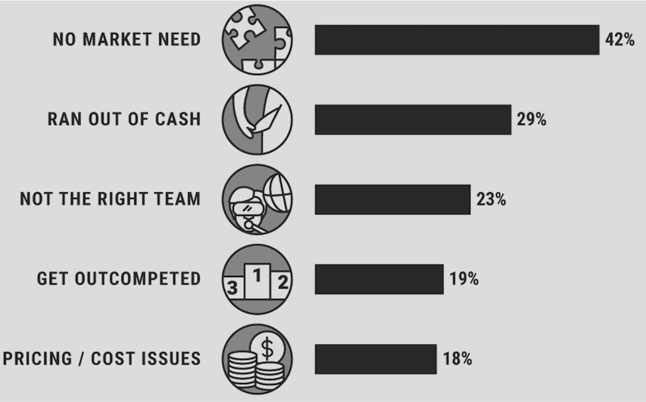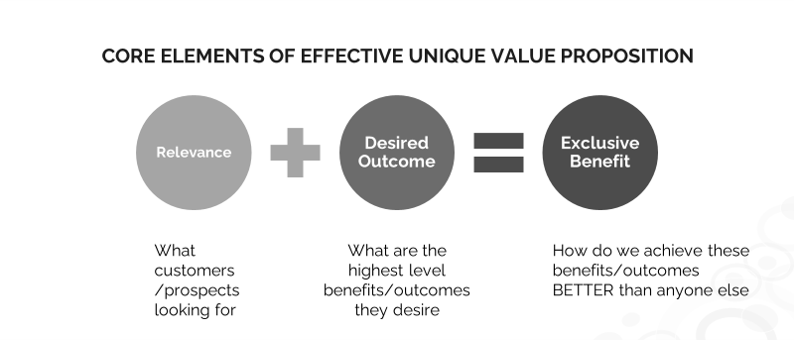.png?width=750&height=375&name=Product-Market%20(1).png)
Earlier this year, I was invited to run a workshop on Product-Market Fit at Boston College Carroll School of Management for a group of entrepreneurial students from the Accelerate@Shea program. As we move into 2023, I believe this topic is crucial for any emerging company or for any company launching a new product to drive early business success and growth.
Ask yourself: How do I get to product-market fit as a startup?
Honestly, it doesn't matter if your product or service is innovative. It's all about whether customers need it and are willing to pay for it. If your product fits into the market, it is where it is supposed to be, and you grow your business.
The #1 number one reason startups fail is that they bring a product to the market that no one actually wants.

42% of startups fail partly because their product does not satisfy a market need. Source: CB Insights
It's imperative to go through the hard steps to apply product-market fit to include completely new products and new features or subsets of an existing product that a team wishes to launch.
Here are five steps to develop your market fit:
Step 1: Identify your market category
Your first and most important task is to identify your market segment, which is defined as a group of businesses or people with similar needs and wants. Companies should focus on the industry that they have the greatest chance of satisfying. A good market segment should be:
- Identifiable - You should be able to describe a segment according to descriptive characteristics (geographic, demographic, and psychographic) or behavioral considerations.
- Substantial - The segment you choose should be large enough for you to make a substantial profit.
- Differentiable - When segmenting the market, ensure that different target markets respond differently to different marketing strategies. If a business only targets one segment, this might not be as much of an issue.
- Accessible - Customers and/or consumers should be easily reached at an affordable cost for your chosen segment. This helps determine how certain ads can reach different target markets and how to make ads more profitable.
- Measurable - The segment size and purchasing power of your chosen market should be measurable with quantifiable data.
- Actionable - Lastly, your market segments need to have practical value and be able to respond to a certain marketing strategy or program, and have easily quantifiable outcomes.
Step 2: Identify the target customer
The next step is to understand better WHO will buy your product or solution and WHY they want it.
To grow and sell more efficiently and quickly, you must deeply understand the people who buy from you. A great way to get that understanding is to develop buyer personas so that your team understands who they are building the product for. A persona is a fictional representation of people involved in your buying cycle and focuses on your ideal customer's pain points.
Step 3: Know Your Product
Next, it's time to understand your customer’s WHY and WHAT'S IN IT FOR THEM. What benefits does your product offer your customers? And what value do those benefits bring to your customers' lives? Make a list of all your product's benefits and translate them into what value they bring. Every potential buyer has some drivers that guide their purchasing behavior. For example, if the feature is easy-to-use, the value increases productivity. Here is a list of some of the most popular forms of business value.
- Increased productivity
- Increased revenue
- Faster time to market
- Decreased cost
- Increased profitability
- Improved efficiency
- Increased market share
- Better agility
Step 4: Know Your Competition and Differentiators
You need to determine how your product will be differentiated from competitive products. How will your product outperform the others? Pick your top 3 and do your homework to see how you differ from the alternatives.

Focusing on areas where your competition doesn't excel is tempting, but you'll have a better idea of where your product or service fits within the market if you key in on your competitors' strengths.
Step 5: Test your Value Proposition with Marketing
Lastly, your value proposition is your plan for how your product will meet customer needs better than the alternatives. 
Start testing your value proposition statements by marketing to prospects and measuring the outcomes. Small companies have an advantage in that they can move fast, customers expect less, and they can react to problems quickly. It's important to closely monitor your program's performance - track active users, survey customers, and listen to your users. If your new product gains momentum on its own and you notice a demand for it that is growing, you likely chose a market where users have a real problem and are on track to achieve product-market fit.
Do you need help with your product-market fit? Check out our Company Message Essentials below.
D




